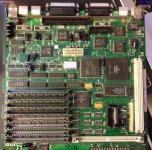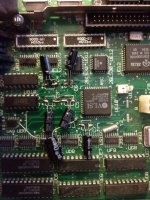RWallmow
Veteran Member
Been so much talk of bad caps and re-capping lately, I decided to re-cap my SE/30.
Old caps were so bad they almost fell off the board, very light pull and they came right off cold, I didn't even have to desolder them.
Mind you I am not very good at surface mount soldering, and all I had on hand was radial-lead capacitors, so it is not going to win any best of show awards, but she runs like the day she was new ;-)
re-capped board: pile-o-blown-caps:
pile-o-blown-caps:  Closeup of C2-C7:
Closeup of C2-C7: 
Old caps were so bad they almost fell off the board, very light pull and they came right off cold, I didn't even have to desolder them.
Mind you I am not very good at surface mount soldering, and all I had on hand was radial-lead capacitors, so it is not going to win any best of show awards, but she runs like the day she was new ;-)
re-capped board:
 pile-o-blown-caps:
pile-o-blown-caps:  Closeup of C2-C7:
Closeup of C2-C7: 
Last edited:
